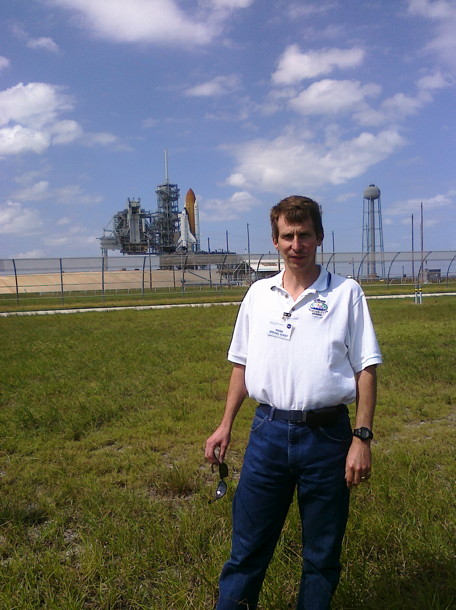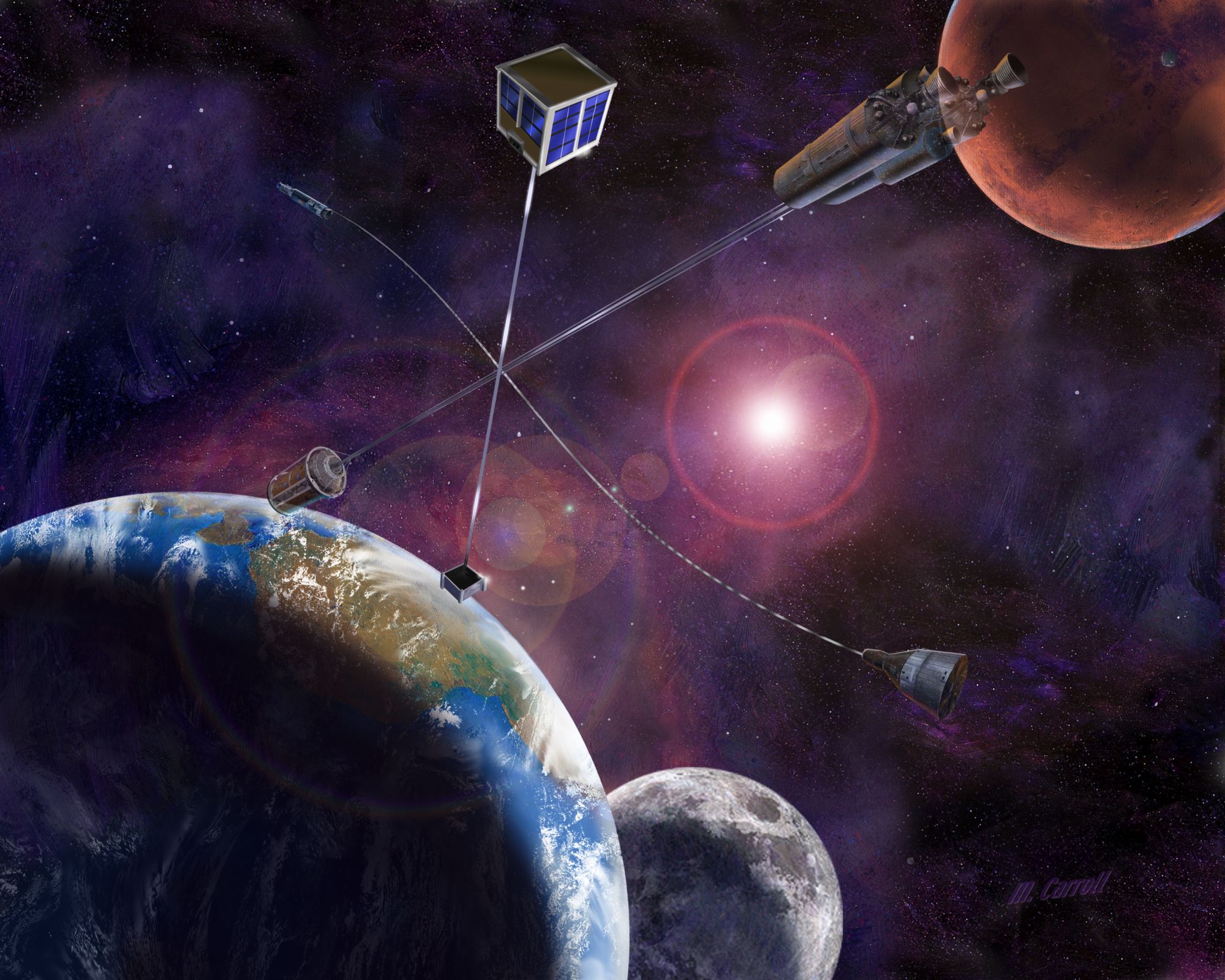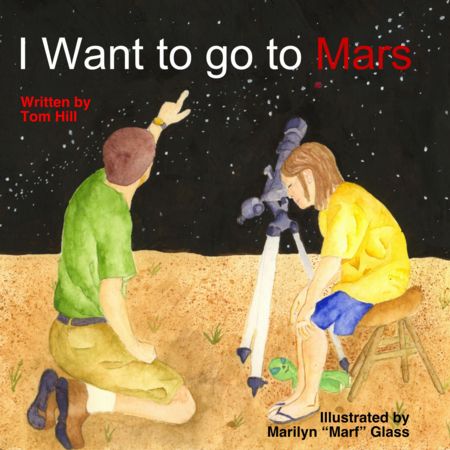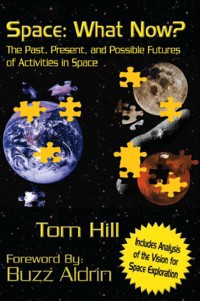|
|
 |
|
Here's the latest on space, and my opinions on it... This is the legacy site, with blog
entries from November, 2004 through June, 2011. Updates after June 9, 2011 can be found at http://spacewhatnow.com/SWN
|
 |
|
|
Saturday, May 28, 2005
Changing Delivery Method...What About Content?
I'm not a big fan of NASA TV. I feel it's a waste of a tremendous possibility, and only ever see it if I'm on a rare channel-surf. The capability that
NASA has to gather raw footage in astronaut training, hardware tests done around the country, and actual events is unmatched,
yet the delivered product to the customer (at least the last time I saw the channel) is typically a view toggling live images
back and forth between viewing outside the ISS and the mission control crew.
In SWN, I propose a news-oriented format for a portion of the day, along with live coverage of astronaut training, especially
simulator flights. Computer graphics could give a great feel for what is going on, and technical data on the web would allow
watchers to gather more detail about the scenario if they like. The public could submit ideas for simulations, and the winners
could be brought to Houston to help present the inputs. There's more, of course.
Commercials would be out of the question unless there's a change in regulations or some sort of special corporation is set
up with a relationship to NASA.
Anyway, looks like they're ponying up the money to switch to digital format. Looks like it'll give people some flexibility in acessing specific events, but there's no mention in an overall programming
change.
Thursday, May 26, 2005
A True Space Corresponent...Almost, and Some Roadmaps
As it turns out, just before Columbia made its last fateful trip back to Earth, Miles O'Brien, CNN's science correspondent,
was in late negotitations to fly on a shuttle mission. Apparently, a sticking point in the negotiations was the 2+ year training timeline, then came February 1st, 2003.
NASA released a series of roadmaps today. As Jeff Foust points out, there isn't a lunar roadmap included. I glanced through the Mars roadmap. It seems to say many of the right
things, but the timeline is stretched out to 2035. Of course, that's what they were asked to produce, so we can't fault them.
Tuesday, May 24, 2005
Funny how Stuff Like This Happens...
Have you heard the talk of possibly shutting down the Voyager probes? Well, it just so happens they've made a new discovery, or at least it's poised to do so. Amazing. I'm sure that none of this will be mentioned in the deliberations of "shut
down" (warning: sarcasm light blinking). My earlier thoughts on Voyager can be found here.
Monday, May 23, 2005
ISDC Info
Spent the last few days at ISDC. I had a good time, and got some insights on Virgin Galactic and more info from Peter Diamandis.
For me, the highlight was a talk given by Rusty Schweikart. The info is here. Basically, he looked at some of the possibilities of post-2029 pass impacts for asteroid 2004 MN4.
Hobbyspace has more info here. Page down to the May 22nd entry.
Sunday, May 22, 2005
Preemptive Regulation
Remember that big space advertisment that caused such a fuss? No? That's because there hasn't been any successful ones yet.
Don't worry, your friendly FCC is on the case to prevent anything like it from happening. Apparently, there's a law on the books, but they don't have the authority to
enforce it right now.
This strikes me as odd.
Monday, May 16, 2005
Ask Someone Close to the Source
If you want to get the best information, ask someone who's done the work and continues to do so. CNN talked with Burt Rutan. He's pretty blunt about the difference in promise right now between sub-orbital and orbital flight. Granted, he's working
in the sub-orbital environment right now, so his view might be a bit...biased.
Sunday, May 15, 2005
A Fitting Farewell
I Watched the last two episodes of Star Trek Enterprise on Friday. I liked the montage of "Space...the final frontier"
featuring all the Enterprises with their respective captains saying part of the phrase.
Because I am who I am, I also noticed the moon-Mars setup they had as part of the second-to-last episode. Mars appeared to
be partially terraformed, because the crew could use simple filters and coats instead of spacesuits when they were outside.
There was also an interesting exchange between Archer and the bad guy (forget his name). In it they discussed how mining
transformed the moon and how that wasn't the approach elsewhere.
8:20 pm est
Washington Post Magazine
I'm assuming the article was timed to be in place for the launch of Discovery, but scheduling realities caught up with
it. The Washington Post Magazine has a cover article on the group of people working to put our space future in motion. It focused mostly on mainstream NASA stuff, but he does
touch on The X-Prize and SpaceX. He also got some input from a "bright, young aerospace engineer."
Note: As typically happens, I talked with the reporter for a while, and while I'm sure he tried to keep all the facts I threw
at him straight, it didn't come out the way I intended. We talked about He3 mining and its ability to power fusion reactors
here on Earth (if we had any), and we also talked about fuel for rockets mined from the lunar soil (possible, but not a good
mass trade-off until we have a major interstellar infrastructure). He appears to have mixed the two topics to thinks that
we should go to the moon to mine He3 and use it to take us to Mars. Oh well.
Friday, May 13, 2005
A Man With a Mission
Well, a lot is happening at NASA now with Mike Griffin in charge. So far, the guaranteed winners appear to be the Vision
for Space Exploration and Hubble. Rand Simberg has more commentary.
I thought I'd feel happier about it.
Tuesday, May 10, 2005
CEV Opinion Piece/Star Trek Pre-Mortem
While I don't share Jeff Bell's literary style, his piece CEV-The Last Battlestar? sure makes you think.
The Washington Post had a discussion on Star Trek, getting ready to shut down its engines (I believe) for now. Overall, I liked the piece(free registration required), especially the part about fans making their own versions of the original series episodes. There's one point, near the end, where they lost me: The "Trek" franchise appealed
to the exploratory curiosity of mankind. Once upright, we set out across the next mountain range; later, we set sail on the
oceans. Space is the logical extension. Except it's not. Space is not a good place for humans. The more we know about it,
and the more lives we lose to it, the better Earth seems. I don't buy that the realization that "space is hard"
has to do with a decrease in watchership. I, for one, stopped watching Star Trek as part of a general decrease in TV watching.
There are plenty of options around today for science fiction on TV that weren't around even in the 80s or early 90's. It's
even possible that some people have moved into an appreciation of a more serial-type of show like Battlestar Galactica. Oh, by the way, Jeff Bell has a comment on that, too.
Sunday, May 8, 2005
Fertilizer for Alternate Sci-Fi History Writers
I enjoy reading the genre, but prefer to write about things that can happen starting today to writing about things that could
have happened by now if...
Shayler's book talk about all the feasibility studies that were done during Apollo - upgraded Saturn Vs, LM labs, rescue vehicles,
you name it. I haven't read it thoroughly yet, but wanted to get the word out.
2:14 pm est
Wednesday, May 4, 2005
So, What did he say, and What did it Mean?
There are a few discussions going on out on various blogs about Mike Griffin's talk at the WIA Breakfast. some of the discussions actually have to do with what he said. Other discussions have more to do with who paid the entrance
fee for someone who wrote about it. While I know that conflicts of interest exist, and try to keep them in mind as I read
things, I don't believe that there's a big issue in the case in point.
The focus is on his comments related to commercial involvement in the next round of space exploration. I cannot
put public money at risk depending on a commercial provider to be in my critical path. He might not decide to show up, for
good and valid business reasons. I cannot put return to the Moon and the Crew Exploration Vehicle… at risk, based on whether
or not a commercial provider decides that he actually wants to do it that way. But I can provide mechanisms where, if a commercial
provider shows up, government will stand down… I don't want to pick winners, but I do want to be able to reward them. I
take these statements to mean, essentially, "If we pick a contract winner we're guaranteed to get what we want, but if we
just say we want things then we're not." This is clearly thinking in a civil-service vein, but in my opinion it simplifies
the argument too much. Elon Musk promoted one idea in congressional testimony, where the government lets a contract for a certain action, then offers a prize of 1/10 the contract value to anyone else
who accomplishes the contract's goal. If the separate interest achieves the goal, the original contract is cancelled. Of
course, in practice this idea is not simple to implement, and lawyers will make lots of money haggling over whether the "necessary"
portions of the goal were accomplished, but it would certainly light a fire under any traditional government contractor working
to do something, and probably give them pause before asking for more money or an extension to the contract.
Of course, if only one contractor (or one team) is working on your hardware, there's still a chance that they'll reach an
impasse. The way this is usually handled in contracting is to re-negotiate the contract for more money, more time, and usually
a decreased capability to allow the project to go forward. Granted, everyone gets to save face because the contractor still
"shows up", but it doesn't do a lot for new ideas.
So, it looks like our new NASA administrator is set on the idea of heavy lift in general and shuttle-derived heavy lift in
particular. It should serve the purpose of moving some people beyond LEO, but I'm concerned about the kind of infrastructure
it will leave behind for the rest of us.
Tuesday, May 3, 2005
A Tale of two CEVs
Lockheed Martin's design for their Crew Exploration Vehicle (CEV) has hit the web. I first heard about it through Rand Simberg's site, and there's a spirited discussion going on about it. I'd like to host such discussions here, but my blog engine doesn't
allow it.
Anyway, a single view of the concept can be found here, while multiple views and some analysis can be found at space.com.
In review, Boeing's concept has been out for a while, although, as Rand says, it's not clear that this is what they put forward. It includes mutliple
parts, showing how different combinations can be put together for different missions.
Now, each talk has varying degrees of detail, so this analysis cannot be considered complete. Lockheed Martin's (LM) concept
requires two launches to achieve the image pictured in the Popular Mechanics article, while Boeing doesn't specify the number
of launches required for it's vehicles. If the LM picture is of a lunar transfer CEV, then it's likely that the Boeing design
requires at least two launches as well.
The wings on the LM concept trouble me. Before I get a bunch of Aha! emails saying that the LM concept is a lifting body,
let me set the record straight...call them what you want, from a top view they look like wings, and I'll stick with that designation.
I worked on a study in college where we debated on having wings on, of all things, an Assured Crew Return Vehicle ( ACRV) that could later be used for other purposes. Of course, we didn't have the exact terms then, but one could easily imagine
The Moon, Mars and beyond...
Anyway, wings have advantages, in that they decrease g-loading that the crew experiences, and they increase cross-track range
(how far a craft can deviate from its orbital path) during landing. The shuttle required wings to meet some military missions,
but of course that was before the military decided to stop flying anything on the shuttle. Wings also have some liabilities,
though. For a given volume, a winged vehicle will usually weigh more than an unwinged vehicle. Combine this with the bragging
rights LM claims in the space.com article of redundant heat protection (gotta make sure that you're new design doesn't suffer
from a design flaw of the old design...never mind that this would likely fly on top of a booster instead of next to one, like
the shuttle does) and you've got a very heavy vehicle. It's unclear how much support a vehicle that heavy could give to a
Moon or Mars mission. Speaking of Moon or Mars missions, you eventually want to return from such a mission. Doing so with
wings hasn't been done yet, and the entry speeds are a lot higher. I'm sure that the structure can be made to take the stress,
but once again you're cranking up the mass of the vehicle, and the return from Moon/Mars missions mass isn't required for
flights into orbit. Things get complicated quickly.
In the comments section to his post, Rand pointed out that all of this is idle discussion until we know more about the mission
profile. I suppose I'll have more to say then.
Monday, May 2, 2005
Looking...Again?
Here's something interesting at Space.com. According to the article, the search for the Mars Polar Lander has started again, using the new imaging techniques
that have provided the excellent views of the landing areas for Spirit and Opportunity. I wish them luck, but one of the reasons they got such good
pictures of our rovers is that we knew where they landed. Part of the problem is that we don't know where Mars Polar Lander
landed. The new procedure provides excellent resolution (read: can see small stuff) but likely at the cost of coverage area
(read: can't see much of the small stuff).
|
|
|
 |
|
|
|
 |
|
Space: Search Now! with Google
| Tom and Discovery |

|
| Taken During a Tour of KSC on 6 Oct 2010 |
| TEMPO³ Update |

|
| Click on the picture to go to the Mars Society TEMPO³ Page |
| Solar System Ambassadors |

|
| Click on the image above to see Tom's SSA profile |
Email Comments to tom [at]
spacewhatnow.com
| Latest book! Click on the cover to purchase |

|
| I Want to go to Mars is a picture book for beginning readers |
More information on I Want to go to Mars can be found in the devoted section of this web site.
Join the Space:What Now? email list for updates on book events or articles published by the author. Email
addresses will not be shared.
I kind of wrote this off, thinking I was being spammed, but I'd like to know if people are really signing up. Please enter
the text you see below in the second line, and I'll get a warm, fuzzy feeling that people are actually reading and signing
up for mail!

| Now Available! |

|
| Clicking here will take you to purchasing options for SWN |
| Get your SWN Gear! |
|
|
| Powered by CafePress |
|
 |
|
|
|
|
|
Scotty
The Updated Past, Present and Possible Futures of Space Activity
|
|
|
 |

